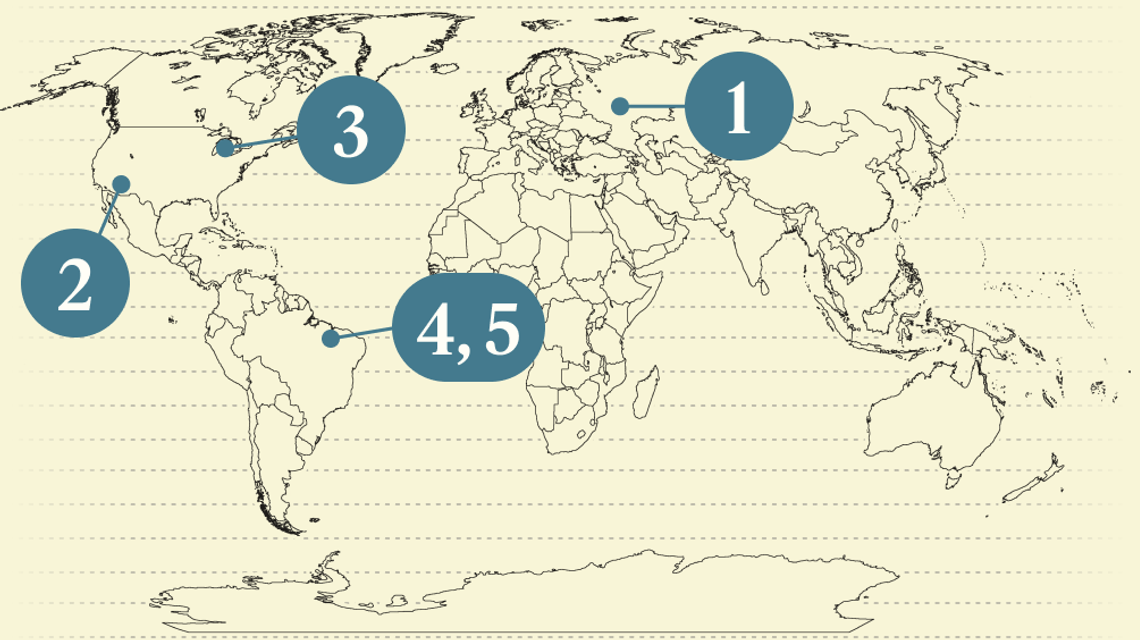| | The absence of the Trump administration from this year’s climate negotiations will create a diplomat͏ ͏ ͏ ͏ ͏ ͏ |
| |  | Net Zero |  |
| |
|
 - Sanctions pressure cools
- Solar shrinkage
- Costly coal plants
- New COP30 strategy
- The case for Belém
 Google’s new nuclear strategy. |
|
 It’s that special time of year again: Climate Week NYC is coming up in about a month. What used to be a sleepy sideshow to the UN General Assembly is now a sprawling panoply of tech-focused talks, showcases, and happy hours. It may be too sprawling, some people think; I’ve heard from organizers that there’s an effort underway to make the whole thing a bit tighter and more focused so people can spend less time sweatily sprinting across Manhattan between events and more time making meaningful and profitable connections in the climate biz. As usual Semafor will be putting together a number of our own fantastic events: I’ll host a Nights of Net Zero cocktail party the evening of Sept. 23 that will feature several leading voices in the AI-energy debate, we’ll have our big Next 3 Billion event on Sept. 24 featuring a brilliant cast of A-list public- and private-sector leaders from emerging economies, and as usual I’ll organize an open get-together for the Net Zero fam the night of Sept. 25. Hope to see you there! |
|
 Alexander Drago/Reuters Alexander Drago/ReutersAs far as the oil market is concerned, Monday’s meeting between US President Donald Trump and leaders from Ukraine and Europe looked like a small step toward peace. Brent crude prices ticked down after the latest Oval Office meeting between Trump and Ukrainian President Volodymyr Zelenskyy ended with only vague security assurances but at least avoided a catastrophic showdown like their last such meeting in February. Tighter direct US sanctions on Russia’s energy industry — which Trump has repeatedly threatened in the past, but has mostly avoided implementing — appear unlikely for now, Anthony Rapa, co-chair of the international trade practice at the law firm Blank Rome, told Semafor. That position puts the administration increasingly at odds with both parties in Congress: Sen. Lindsey Graham (R-S.C.) is still pushing hard for legislation to penalize buyers of Russian energy, and a new report by Senate Democrats warned that Trump’s loose enforcement of existing sanctions and reluctance to approve stronger ones have ensured “Ukraine loses leverage and Putin’s incentive to come to the negotiating table dissipates.” Secondary sanctions, for example on China, are tricky, Rapa said, because they complicate broader trade negotiations. One exception is India, which will face steep new tariffs starting next week as a punishment for its purchases of Russian crude oil, which Trump’s trade advisor Peter Navarro said on Monday are “deeply corrosive of the world’s efforts to isolate Putin’s war economy.” In the meantime, Ukraine continues to apply its own pressure on Russia’s oil industry: An attack Monday by Ukrainian long-range drones shut down the Druzhba pipeline that carries Russian oil to Hungary and Slovakia. |
|
 The Trump administration’s latest crackdown on renewables will drive a wave of consolidation in the solar industry, the CEO of one of the top US developers of large-scale clean energy projects told Semafor. The Treasury Department on Friday laid out new, narrower rules for which wind and solar projects can qualify for tax credits: The rules define when exactly a project counts as being “under construction,” a critical distinction since any projects not under construction by July 2026 will no longer qualify for credits. Previously, projects could qualify either when 5% of their construction capital had been spent, or when “significant” physical construction had taken place. The new rules eliminate the capex option for utility-scale projects. “The physical work rule is much tougher to meet,” said Kevin Smith, CEO of Arevon Energy, because of the much greater amount of time and money required to get substantial construction underway. The upshot of the new rules, he said, is that many small and midsized developers are putting their early-stage projects — or their entire companies — up for sale at steep discounts. For larger developers that can afford acquisitions, now is a good time to boost profits, since the overall slowdown in project development, against a backdrop of rising electricity demand, means that power prices are rising quickly. But for much of the US solar industry, he said, the new rules will “do substantial damage.” |
|
 Estimated increase in annual consumer power bills that will result from a Trump administration order to keep coal-fired power plants running beyond their scheduled retirement. Old plants often cost more to maintain than they are worth, and are routinely shut down after several decades when they’re no longer economically viable. But under Trump, the Energy Department has intervened to force a number of plants to keep running, ostensibly to serve growing demand. Those interventions will ultimately add up to a considerable cost increase for households and businesses, rather than a savings, according to a new study by the research firm Grid Strategies. “Increasing ratepayer costs to subsidize uneconomic power plants undermines the competitiveness of US manufacturing and data centers,” the report concludes. |
|
 André Corrêa do Lago. Kay Nietfeld/picture alliance via Getty Images. André Corrêa do Lago. Kay Nietfeld/picture alliance via Getty Images.The absence of the Trump administration from this year’s global climate negotiations will create a diplomatic “imbalance” with unpredictable results, the COP30 president told Semafor. André Corrêa do Lago, the Brazilian diplomat leading the summit, published an open letter to negotiators today that details some new elements of his strategy to make COP30 a success. These include creating new fora for negotiators to discuss issues like biodiversity and sustainable urban development that aren’t explicitly covered in the core agenda, and launching a series of direct consultations between the COP presidency and negotiators to raise delegates’ concerns early rather than, as has often happened in past COPs, keeping everything close to their chests until the very last minute. The US remains a wild card, Corrêa do Lago told a small group of reporters on Monday. The Trump administration fired the US climate negotiating team in June and has not made any contact yet with the summit organizers. “The US being out is going to force some of the discussions to find a new balance between countries,” Corrêa do Lago said. “That’s neither good nor bad as a definition, but it will have a very strong impact.” With fewer than 100 days before the summit, only a handful of the COP’s 198 national participants have submitted updated climate strategies, the new letter notes, a major shortfall that Corrêa do Lago hopes will be resolved by the time of the UN General Assembly in New York next month. |
|
| | Davi Neustein and Barnabé Colin |
| |
 Wagner Santana/Reuters Wagner Santana/ReutersWith three months to go, in boardrooms and cabinet meetings across the world, dissent is growing around the idea of hosting the 30th UN Climate Change Conference in Belém. As sustainability consultants in Brazil, we keep hearing less about engagement with the concrete COP30 agenda, and more questions about how reasonable it is to organize a COP in the Amazon. When Brazil’s President Luiz Inácio Lula da Silva selected Belém to host COP30 two years ago, it was a bold and controversial choice. A port city of 1.3 million people, Belém is the capital of Pará, a state twice the size of France. And it embodies the region in ways that challenge global assumptions: The Amazon is one of the richest and most important forest ecosystems on Earth, and at the same time one of Brazil’s poorest and most structurally marginalized regions — an export hub in which less than 20% of residents have access to adequate sanitation. Though located in the world’s largest rainforest, Belém has lost nearly 20% of its tree cover in the last four decades. Illegal deforestation and informal urban growth exist hand in hand with rich cultural tradition, youth-led activism, and innovative governance models. The city is nationally recognized as a gastronomic hub, and is a central urban base for Indigenous and traditional peoples’ movements. Center and periphery, ecological and extractive, prosperous and precarious: these contradictions are Belém’s essence today. By bringing COP30 to the Amazon, the Brazilian presidency is holding a mirror to the climate crisis, reflecting a dilemma that at least four billion people are confronted with: how to reconcile the urgent need for development with the long-term resilience needed to survive climate change. Far from a logistical miscalculation, Belém focuses global climate attention on the real, complex, and contested spaces that will determine the success of the transition, where investment in energy, transport, water, and housing must be re-thought to cut emissions, withstand shocks, and safeguard ecosystems, even as local people struggle to meet immediate needs. |
|
 New Energy Leah Millis/File Photo/Reuters Leah Millis/File Photo/ReutersFossil FuelsTechPolitics & Policy- Another failed round of UN talks on plastic pollution — intended to protect oceans and human health — leaves little hope for consensus as long as Trump is in power.
Minerals & MiningEVs |
|
|